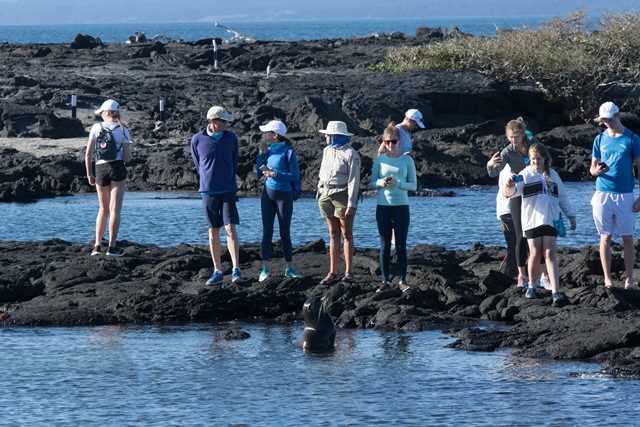We left our calm anchorage at Rábida Island at midnight and navigated north, heading for Isabela Island. I woke the guests at dawn and we sleepily gathered on the ship’s decks. We had barely even made it outside when I spotted a pod of common dolphin (who are not so common!) – about a mile straight ahead of us. Chief mate Christian took the ship up slowly so we could take a closer look and we spent 20 minutes surrounded by leaping and surfing dolphins! I made a ship-wide announcement to alert all the guests as I was sure no one would want to sleep through the chance to see these beautiful marine creatures.
Once the dolphins had dispersed a little, we moved on and left them to their breakfast. Incredibly I spotted a second pod of common dolphins closer to the coast and so we headed to have a look at them. Then to our unending delight, I saw the back of a small unidentifiable beaked whale, and someone observed a misty whale spout! Officer Christian turned the National Geographic Islander around and we spent the next 20 minutes happily watching what I was finally able to identify as a small blue whale! The whale surfaced right beside us and then dove at our bow. The mottled blue gray coloration and the small humped dorsal fin that was positioned far to the back of the animal were the field clues that helped me to identify the species. Later a Bryde's whale and a larger adult blue whale also surfaced! We certainly got more cetaceans than we were expecting this morning – three separate species!
We ate a hearty breakfast and gathered in the bridge to watch the countdown on the ship’s GPS and radar as we crossed the equator from the Northern Hemisphere into the Southern Hemisphere. Soon we anchored below the dramatic cliffs of Punta Vicente Roca and we boarded Zodiacs to explore the coast. We saw dozens of sea turtles, feeding marine iguanas, several mola sunfish and admired the dramatic volcanic landscape.
After a quick change into wetsuits when we returned to the ship, some of our guests went snorkeling. The water was quite cool, but the visibility was good and the wildlife was amazing! We snorkeled among dozens of placid and completely fearless sea turtles. We watched two sea lion teenagers swirl and splash as they played and fought over a fish. And we found marine iguanas feeding under the waves on green marine algae growing on the rocks.
We had lunch and took a welcome siesta. Naturalist Jose met with the National Geographic Global Explorers and they began a video project. Following naturalist Vanessa’s interesting presentation on Charles Darwin, we prepared for the afternoon visit to Punta Espinoza. We disembarked on the black ropey lava flows of Fernandina and were amazed at the variety and amount of wildlife here! We stepped carefully among the basking marine iguanas, and watched newborn baby sea lions as they nursed and rested on the sand. Some of us spotted a Galápagos racer, a constrictor snake that feeds on baby marine iguanas and lava lizards. And near the end of our hike we saw a beautiful chocolate-brown adult Galápagos hawk.
We returned contentedly to the ship and climbed to the sky deck to watch as the sun set in a shining golden ball behind the island.






